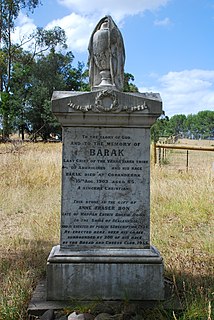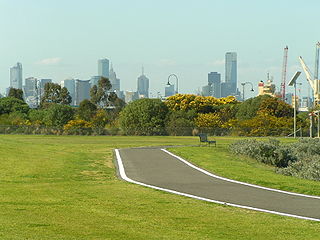Traditional Life
The Yalukit traditionally practiced tool manufacturing, ochre collection, and burning of the landscape to allow for renewal of the flora and fauna. The Yalukit land currently occupied by Central Melbourne is a major meeting place for the Kulin Nation where social events, ceremonies, marriages, initiations, trade, and judicial matters are conducted. Yalukit people are of the Bundjil moiety and so were required to marry outside of the clan to people of the Waa moiety in the surrounding Kulin nation; married Yalukit women would move away from Yalukit lands to live with other clans. Yalukit people hunted kangaroo, birds, eels and other seafood, and gathered edible plants such as wattle gum. While men primarily hunted the large game, women were also capable of doing so. The work required to sustain the clan could take as little as five hours a day. Food was shared freely with those less-able within the clan.
Decision-making within the clan was conducted by a senior council which met to discuss serious issues such as clan movements, inter-tribal business, or to resolve interpersonal conflict. As winter approached, the clan would move upstream to drier areas that were less prone to flooding.
Clothing was sewn from animal skins and furs including possum and kangaroo and also woven from plant materials. Hair was kept long and decorated with claws, animal teeth, earthenware, and other accessories. The ears and nose could be pierced with animal bones and the face painted with ochre.

The Yarra River or historically, the Yarra Yarra River, is a perennial river in south-central Victoria, Australia.

Port Phillip , or Port Phillip Bay, is a horsehead-shaped enclosed bay on the central coast of southern Victoria, Australia. The bay opens into the Bass Strait via a short, narrow channel known as The Rip, and is completely surrounded by localities of Victoria's two largest cities — metropolitan Greater Melbourne in the bay's main eastern portion north of the Mornington Peninsula, and the city of Greater Geelong in the much smaller western portion north of the Bellarine Peninsula. Geographically, the bay covers 1,930 square kilometres (750 sq mi) and the shore stretches roughly 264 km (164 mi), with the volume of water around 25 cubic kilometres (6.0 cu mi). Most of the bay is navigable, although it is extremely shallow for its size — the deepest portion is only 24 metres (79 ft) and half the bay is shallower than 8 m (26 ft).

The history of Melbourne details the city's growth from a fledgling settlement into a modern commercial and financial centre as Australia's second largest city, Melbourne, in the state of Victoria.

The Wurundjeri are an Australian Aboriginal people of the Woiwurrung language group, in the Kulin nation. They occupied the Birrarung Valley before British settlement of the area, around the present location of Melbourne, and were called the Yarra tribe by the settlers. The Wurundjeri are one of several sub-groups or clans of Woiwurrung people who traditionally occupied some of the territory now the site of the city of Melbourne. There were two separate clan groups, Wurundjeri-balluk and Wurundjeri-willam.

Williamstown is a suburb of Melbourne, Victoria, Australia, 11 km (6.8 mi) south-west of Melbourne's central business district in the local government area of the City of Hobsons Bay.

The Kulin nation is an alliance of five Indigenous Australian nations in south central Victoria, Australia. Their collective territory extends around Port Phillip and Western Port, up into the Great Dividing Range and the Loddon and Goulburn River valleys.

The Merri Creek is a waterway in southern parts of Victoria, Australia, which flows through the northern suburbs of Northcote. It begins near Wallan north of Melbourne and flows south for 70 km until it joins the Yarra River at Dights Falls. The area where the creek meets the river was traditionally the location for large gatherings of the Wurundjeri people and is suspected to have been the location for one of the earliest land treaties in Australia between Indigenous Australians and European settlers.

The Capital City Trail is a shared use path in Melbourne, Victoria, Australia, which circles the city centre and some inner eastern and northern suburbs. It is 29km in length, and mostly consists of sections of other trails, such as the Merri Creek Trail, Main Yarra Trail, Moonee Ponds Creek Trail and Inner Circle Rail Trail.

William Barak, was a traditional ngurungaeta (elder) of the Wurundjeri-willam clan, first inhabitants of present-day Melbourne, Australia. He became an influential spokesman for Aboriginal social justice and an important informant on Wurundjeri cultural lore. In his later life Barak painted and drew Wurundjeri ceremonies and carved weapons and tools for an audience of local settlers and international tourists. He is now considered a significant Aboriginal artist of the nineteenth century.
The Boonwurrung, are an Aboriginal people of the Kulin nation, who reside from Werribee River to Wilsons Prom, Victoria, Australia, including part of what is now the city and suburbs of Melbourne. Before British colonisation, they lived as all people of the Kulin nation lived, sustainably on the land, for tens of thousands of years. They were called the Western Port or Port Philip tribe by the early settlers, and were in alliance with other tribes in the Kulin nation, having particularly strong ties to the Wurundjeri people.

The Taungurung people, also spelt Daung Wurrung, consisted of nine clans who spoke the Taungurung language and were part of the Kulin alliance of indigenous Australians. They lived to the north of, and were closely associated with, the Woiwurrung speaking Wurundjeri people. Their territory is to the north of the Great Dividing Range in the watersheds of the Broken, Delatite, Coliban, Goulburn and Campaspe Rivers. They were also known by white settlers as the Devil's River Tribe or Goulburn River Tribe.

Coranderrk was an Aboriginal reserve run by the Victorian government between 1863 and 1924, located around 50 kilometres (31 mi) north-east of Melbourne. The residents were mainly of the Woiwurrung, Bunurong and Taungurong peoples, and the first inhabitants chose the site of the reserve.

The Kororoit Creek is a watercourse of the Port Phillip catchment, rising in the outer north western suburbs of Melbourne, in the Australian state of Victoria.

The Hobsons Bay Coastal Trail is a shared use path for cyclists and pedestrians, which follows the coast line of Hobsons Bay in the inner western suburbs in Melbourne, Victoria, Australia. The trail forms part of the western half of the Bayside Trail which encircles Port Phillip. It runs from the west side of the Westgate bridge, south and along the coast, finishing at the Skeleton Creek Trail in Sanctuary Lakes.
Melbourne West Province was an electorate of the Victorian Legislative Council from 1904 until 2006.
Billibellary was a song maker and influential ngurungaeta of the Wurundjeri-willam clan during the early years of European settlement of Melbourne. He was known by various names including Billi-billeri, Billibellary, Jika Jika, Jacky Jacky and Jaga Jaga. He was an astute and diplomatic leader, described as powerfully built with an influence and reputation that extended well beyond his clan.

The Kulin languages are a group of closely related languages of the Kulin people, part of the Kulinic branch of Pama–Nyungan.

Aboriginal Victorians, the Aboriginal Australians of Victoria, Australia, occupied the land for tens of thousands of years prior to European settlement. Aboriginal people have lived a semi-nomadic existence of fishing, hunting and gathering, and farming eels in Victoria for at least 40,000 years.
Ian D. Clark is an academic historian and Toponymist whose primary work has focused on Victorian Aboriginal history, aboriginal toponymy and the frontier conflict between Indigenous Australians and immigrant settlers during the European settlement of Victoria, Australia.

The Woiwurrung, also spelt Woi Wurrung, Woiwurrong, Woiworung, Wuywurung, are an Aboriginal Australian people of the Woiwurrung language group, in the Kulin alliance.












